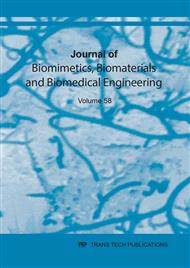[1]
M. Karadjian, C. Essers, S. Tsitlakidis, B Reible, A. Moghaddam, A. R. Boccaccini and F. Westhause.; Review; Biological Properties of Calcium Phosphate Bioactive Glass Composite Bone Substitutes: Current Experimental Evidence; Int. J. Mol. Sci.(2019), 20, 305.
DOI: 10.3390/ijms20020305
Google Scholar
[2]
Q. Chen, C. Zhu and G. Thouas; Review: Progress and challenges in biomaterials used for bone tissue engineering: bioactive glasses and elastomeric composites; Progress in Biomaterials (2012), 1:2.
DOI: 10.1186/2194-0517-1-2
Google Scholar
[3]
S. K. Nandi, A. Mahato, B. Kundu and P. Mukherjee; Doped Bioactive Glass Materials in Bone Regeneration; http://dx.doi.org/10.5772/63266; (2016).
DOI: 10.5772/63266
Google Scholar
[4]
V.G. Varanasi, E. Saiz, P.M. Loomer, B. Ancheta, N. Uritani, S.P. Ho, et al.; Enhanced osteocalcin expression by osteoblast-like cells (MC3T3-E1) exposed to bioactive coating glass (SiO2–CaO–P2O5–MgO–K2O–Na2O system) ions. Acta Biomaterialia. (2009), 5(9): 3536–47.
DOI: 10.1016/j.actbio.2009.05.035
Google Scholar
[5]
C. Wu, Y. Ramaswamy, H. Zreiqat; Porous diopside (CaMgSi(2)O(6)) scaffold: A promising bioactive material for bone tissue engineering; Acta Biomater. (2010) Jun; 6(6):2237-45.
DOI: 10.1016/j.actbio.2009.12.022
Google Scholar
[6]
C. Saravanan, S. Sasikumar; Bioactive Diopside (CaMgSi2O6) as a Drug Delivery Carrier – A Review; Curr Drug Deliv. (2012) Nov; 9(6):583-7.
DOI: 10.2174/156720112803529765
Google Scholar
[7]
R.G. Carrodeguas, E. Córdoba, A.H. De Aza, S. De Aza, P. Pena.; Bone-Like Apatite-Forming Ability of Ca3(PO4)2-CaMg(SiO3)2 Ceramics in Simulated Body Fluid; Key Engineering Materials, (2009), Vols. 396-398, pp.103-106.
DOI: 10.4028/www.scientific.net/kem.396-398.103
Google Scholar
[8]
H. Ismael, b. García-Páeza, P. Pilar, C. Baudina, M. A. Rodrígueza, C. Elcy Cordobaa, H. D. Antonio; Processing and in vitro bioactivity of a ß-Ca3(PO4)2 CaMg(SiO3)2 ceramic with the eutectic composition, Boletín de la Sociedad Española de Cerámica y Vidrio, (2016), Vol.55, Issue 1, 1-12.
DOI: 10.1016/j.bsecv.2015.10.004
Google Scholar
[9]
F.R. Maia, V.M. Correlo, M.N. Neves, R.L. Reis; Book chapter: Natural Origin Materials for Bone Tissue Engineering – Properties, Processing, and Performance, (2019),535-558.
DOI: 10.1016/b978-0-12-809880-6.00032-1
Google Scholar
[10]
G.C. Wang, Z.F Lu., H. Zreiqat; Bioceramics for skeletal bone regeneration, in: K. Mallick (Ed.), Bone Substitute Biomaterials, Woodhead Publishing, (2014), 180-216.
DOI: 10.1533/9780857099037.2.180
Google Scholar
[11]
S.Cavalu, F.Banica, C.Gruian, E.Vanea, G.Goller, V.Simon; Microscopic and spectroscopic investigation of bioactive glasses for antibiotic controlled release, Journal of Molecular Structure (2013) 47-52.
DOI: 10.1016/j.molstruc.2013.02.016
Google Scholar
[12]
Y. J. No, J. J. Li and H. Zreiqat; Review: Doped Calcium Silicate Ceramics: A New Class of Candidates for Synthetic Bone Substitutes, Materials, (2017), 10, 153.
DOI: 10.3390/ma10020153
Google Scholar
[13]
S. K. Arepalli1, H. Tripathi, P. P. Manna, P. Pankaj, S. Krishnamurthy, S. C.U. Patne, R. Pyare, S. P. Singh, Preparation and in vitro investigation on bioactivity of magnesia-contained bioactive glasses, Journal of the Australian Ceramic Society,55, (2019), 145–1552.
DOI: 10.1007/s41779-018-0220-5
Google Scholar
[14]
M. A. Sainz, P. Pena, S. Serena, A Caballero; Influence of design on bioactivity of novel CaSiO3–CaMg (SiO3) 2 bioceramics: In vitro simulated body fluid test and thermodynamic simulation. Acta Biomaterialia, (2010), 6(7), 2797-2807.
DOI: 10.1016/j.actbio.2010.01.003
Google Scholar
[15]
A.A. Batool, I. K. Sabree, S. J. Edrees, effects of MgO wt.% on the structure, mechanical, and biological properties of bioactive glass-ceramics in the SiO2,Na2O,CaO,P2O5,MgO system, International Journal of Mechanical Engineering and Technology (IJMET) Volume 10, Issue 01, January (2019), 97–106.
DOI: 10.1016/s0272-8842(99)00072-3
Google Scholar
[16]
M. Mozafari, M. Rabiee, M. Azami, and S. Maleknia, Biomimetic formation of apatite on the surface of porous gelatine/bioactive glass nanocomposite scaffolds, Applied surface science, (2010), 257, 1740-1749.
DOI: 10.1016/j.apsusc.2010.09.008
Google Scholar
[17]
M.A. Sainz, P. Pena, S. Serena, A. Caballero; Influence of design on bioactivity of novel CaSiO3–CaMg(SiO3)2 bioceramics: In vitro simulated body fluid test and thermodynamic simulation, Acta Biomaterialia, (2010),2, 797–2807.
DOI: 10.1016/j.actbio.2010.01.003
Google Scholar
[18]
N. Toru and T. Sadami, Study of diopside ceramics for biomaterials, Journal of Materials Science: Materials in Medicine, (1999), volume 10, 475–479.
Google Scholar
[19]
C. Wu, J. Chang, Degradation, Bioactivity, and Cytocompatibility of Diopside, Akermanite, and Bredigite Ceramics, Biomaterials and Tissue Engineering Research Center, (2006).
DOI: 10.1002/jbm.b.30779
Google Scholar
[20]
A. S. Kumar , T. Himanshu , M. P. Partha, P. Paliwal , K. Sairam , P. Shashikant , P. Ram , S. P. Singh, Preparation and in vitro investigation on bioactivity of magnesia-contained bioactive glasses. Journal of the Australian Ceramic Society, (2018).
Google Scholar
[21]
P. D. Aza, Z. Luklinska, M. Anseau, Bioactivity of diopside ceramic in human parotid saliva, J Biomed Mater Res part B Appl Biomater, Apr (2005);73(1):54-60.
DOI: 10.1002/jbm.b.30187
Google Scholar


